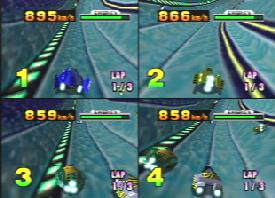Gentle . . . er. . . things, start your engines!
Let’s face it – things are just going to be boring in the future. If the wrong
people get their way, everything fun will be outlawed (i.e. alcohol, cock fighting,
ferret wrangling, professional wrestling, etc.). Without an outlet for its violent
tendencies, the mass populace will rise up and overthrow the ruling class, creating
anarchy and, more importantly, removing me from my position of ultimate power
. . . but I digress. In order to combat this social upheaval, those in power will
have to give the people what they want, a violent action sport where death stalks
you at every turn. That’s where F-Zero X comes into play.
F-Zero X is the sequel to one of the most popular games on the Super Nintendo. Combining high speed racing with well designed tracks and tons of competitors, F-Zero X surely does its predecessor proud. While many will buy the game just on the name alone, there are many aspects to this title that make it more than just a sequel.
First off, unlike the original, F-Zero X is polygonal. Seeing these
graphics makes you wonder how you ever played the original 16-bit version. With
a super high framerate, the race really flies by. On the down side, the tracks
are all very bland looking, with boring textures and uninspired backgrounds.
But while other arcade racing game have demonstrated better graphics before,
like Extreme
G, none of have had to deal with quite so much processing power per race
just to create your enemies.
In every race, you are up against twenty-nine other hover cars. Your placement among these other cars depends on how well you did on previous tracks. The better you finish, the worse the starting position. This makes for some claustrophobic beginnings as you swerve your way through the competition. The other cars aren’t the only thing you have to worry about though . . .

The tracks are just as much your enemies as the cars. Besides normal tracks, you race on tracks without walls, on tracks with long jumps, on a half-pipe, on the inside of a tube, and even on the outside of a tube. With over thirty tracks, the replay value is immense. There’s even a track where all of your opponents kill themselves right at the beginning, so you win if you survive. The largest problem with this setup, however, is that just by racing the tracks once, you have an advantage. Most tracks only have one tricky section; once you know where that is, you’re made in the shade.
This can be especially annoying during a multi-player game. It’s not really
fun for someone to play against the owner of the game, because unless he falls
off the track, he wins. In order for the multi-player to work, you have to give
your friends time to practice . . . unless you want to just grind them into
the dirt like the lowly scum that they are.
Other than that, the multi-player game works amazingly well. There is really
no framerate loss due to the fact that the machine only has to render four cars
in the multi-player game. While the quadruple split-screen can make things hard
to see, N64 owners are used to that after thousands of hours playing multiplayer
Goldeneye.
All in all, this game is plain fun. Nothing really new, but nothing bad either.
While the game lacks some things, like weapons and multiple paths, it is a fast
racer that many gamers will enjoy playing for hours and hours. And maybe, just
maybe, it’ll keep the proletariat in line and I won’t have to sacrifice my throne
as ruler of you all. Mwahahahahaha . . . uh, pretend you didn’t see that.







